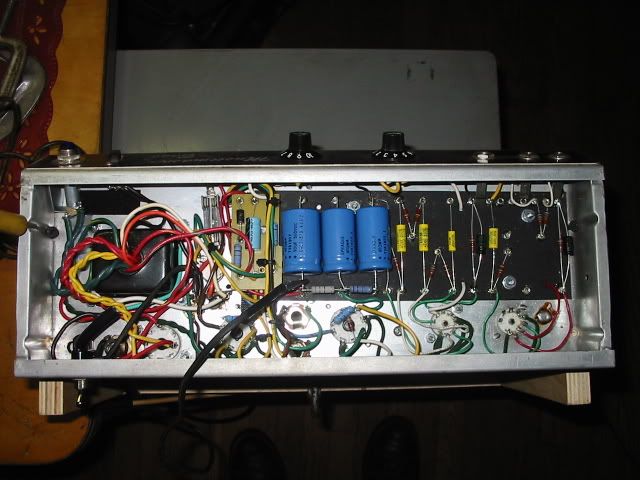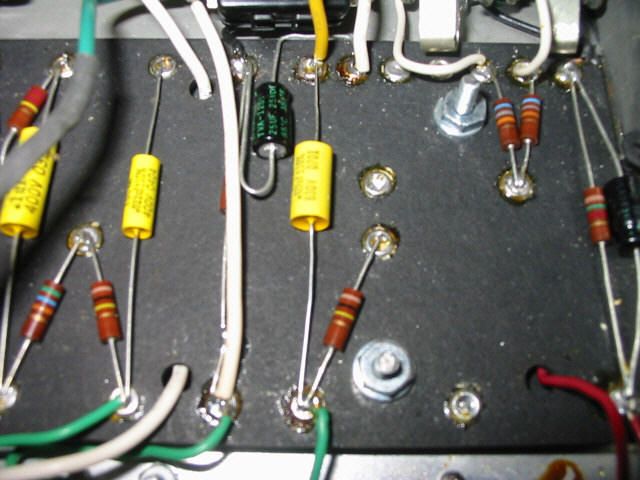here is the schematic.

I was playing the amp the other day and using my strats with standard PU's past 4 it begins to break up and the breakup is not smooth. I usually play it below 4 . If you look at the schem is what I built basically a 5E3 with larger tranny's because I have a higher voltage than a stock 5E3 . I was looking for headroom and up to 4 on the vol it is clean and pretty loud and I can live with that. However I did add a switch stdt to switch out the 25uf second gain bypass cap and add in a 112K NFB loop like an 6G2 brown princeton only double the resistance just so I did not get quite as much NFB and it also has a adj/fixed bias and the tone stack is the same as the 6G2 .
So would you say I basically built a high voltage 5E3 with one vol and one tone and two inputs . I just use one triode of the 12ay7 preamp . I did wire it at first like the 5E3 tone stack but it broke up far to soon so I changed the wiring like the 6G2 and it did not break up nearly as soon. Don't know exactly why but it did change the amp it was not acting like a 5E3 anymore.
I built it using larger tranny's the OT is twice the size as a BF deluxe and the PT has 325-0-325 @150mA .
I added the switch so it would be more like an 6G2 with no bypass cap and a NFB loop so if I switch this in to get the same vol as with the bypass cap and no NFB I need to turn the vol up 2 numbers .
My goal was clean headroom with good bottom end . It does not lose the bottom end switched to NFB mode it's just tighter. On 4 it is pretty loud and with the NFB no bypass it does break up but a lot later on but the sound is not quite the same thing , it's tight and loses overtones. I wanted to add a switch just to cut out the second gain bypass cap and not add the NFB but I like both options. I used the same switch fender used for the ground switch and that's all that will fit in this build.
So what can I do to get more headroom past 4 without the NFB loop and the bypass cap in play because it sounds best set that way. I don't want to lose the bottom end .
Can I use a 12at7 instead of the 12ax7 for the second gain and PI or if I use the other triode of V1 12ay7 and wire one input to the unused triode without a bypass cap to drop the gain and if I do that I need to change the input resisters to 33K ohm instead of 68K ohm, can I just leave the one vol pot if I do this and leave the 1 meg resister to ground as is ? I don't have room for another vol pot so say if jumper the grid pin on the 12ay7 and say plug into the input with no bypass cap will the triode that has the bypass cap being not plugged into go to ground through the 1 meg and the one vol pot will work with either triode or do i need a dual gang vol pot?
I know this is asking a lot but it's just a thought . I don't need a high and low input set. I don't have any room to add more switches and if I tried they would be on the back of the chassis real close to the preamp tube V1 and second gain and PI V2 so doing that I may create some noise . here is a photo of the chassis inside.

this is the area the switch fit in


I was playing the amp the other day and using my strats with standard PU's past 4 it begins to break up and the breakup is not smooth. I usually play it below 4 . If you look at the schem is what I built basically a 5E3 with larger tranny's because I have a higher voltage than a stock 5E3 . I was looking for headroom and up to 4 on the vol it is clean and pretty loud and I can live with that. However I did add a switch stdt to switch out the 25uf second gain bypass cap and add in a 112K NFB loop like an 6G2 brown princeton only double the resistance just so I did not get quite as much NFB and it also has a adj/fixed bias and the tone stack is the same as the 6G2 .
So would you say I basically built a high voltage 5E3 with one vol and one tone and two inputs . I just use one triode of the 12ay7 preamp . I did wire it at first like the 5E3 tone stack but it broke up far to soon so I changed the wiring like the 6G2 and it did not break up nearly as soon. Don't know exactly why but it did change the amp it was not acting like a 5E3 anymore.
I built it using larger tranny's the OT is twice the size as a BF deluxe and the PT has 325-0-325 @150mA .
I added the switch so it would be more like an 6G2 with no bypass cap and a NFB loop so if I switch this in to get the same vol as with the bypass cap and no NFB I need to turn the vol up 2 numbers .
My goal was clean headroom with good bottom end . It does not lose the bottom end switched to NFB mode it's just tighter. On 4 it is pretty loud and with the NFB no bypass it does break up but a lot later on but the sound is not quite the same thing , it's tight and loses overtones. I wanted to add a switch just to cut out the second gain bypass cap and not add the NFB but I like both options. I used the same switch fender used for the ground switch and that's all that will fit in this build.
So what can I do to get more headroom past 4 without the NFB loop and the bypass cap in play because it sounds best set that way. I don't want to lose the bottom end .
Can I use a 12at7 instead of the 12ax7 for the second gain and PI or if I use the other triode of V1 12ay7 and wire one input to the unused triode without a bypass cap to drop the gain and if I do that I need to change the input resisters to 33K ohm instead of 68K ohm, can I just leave the one vol pot if I do this and leave the 1 meg resister to ground as is ? I don't have room for another vol pot so say if jumper the grid pin on the 12ay7 and say plug into the input with no bypass cap will the triode that has the bypass cap being not plugged into go to ground through the 1 meg and the one vol pot will work with either triode or do i need a dual gang vol pot?
I know this is asking a lot but it's just a thought . I don't need a high and low input set. I don't have any room to add more switches and if I tried they would be on the back of the chassis real close to the preamp tube V1 and second gain and PI V2 so doing that I may create some noise . here is a photo of the chassis inside.

this is the area the switch fit in

 I think I need to find a local band just so I can play my guitars and amps.
I think I need to find a local band just so I can play my guitars and amps.
Comment